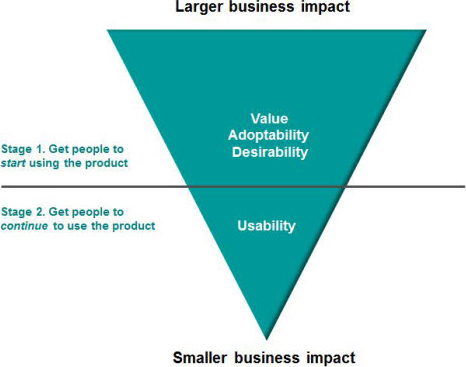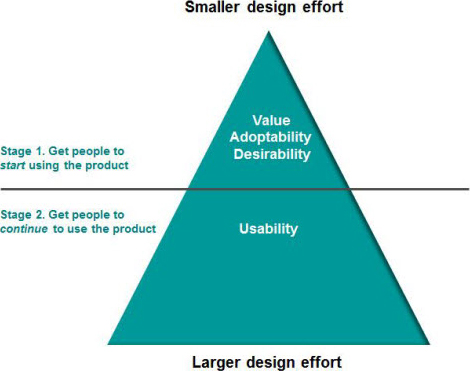Stage 1—Getting prospective users to start using a product—for example:
- persuading shoppers to start using Groupon to find good deals
- getting users to download and start using the Yahoo! Toolbar for Web browsers
- persuading home buyers to start using Zillow.com to search for a new home
- prompting runners to start using the RunKeeper mobile app to track their progress and improve their fitness
Stage 2—Getting existing users to continue using a product—for example:
- encouraging shoppers to rely heavily on Groupon for shopping
- getting users to habitually use the Yahoo! Toolbar
- encouraging home buyers to visit Zillow.com repeatedly by satisfying their needs
- providing an easy-to-use and engaging experience on RunKeeper for runners’ fitness-related tasks
To better understand the business impact and design effort for these two stages, let’s look at the diagrams shown in Figures 1 and 2, respectively.


Getting Users to Start Using a Product Is Key to Business Success
In light of business impact, the first stage is more important, because a business can generate revenue only once users have started using a product. Value, adoptability, and desirability have a greater impact on the first stage, while usability has a greater impact on the second stage, when users’ ability to complete their tasks successfully is a determining factor of their experience.
If you design a product to support value, adoptability, and desirability, people will start using the product. On the other hand, if a product design excels in usability, once users start using the product, they’ll be able to perform their tasks successfully. But it’s still necessary to answer the million-dollar question: How can you get people to use the product in the first place?
Of course, value, adoptability, and desirability play a role at Stage 2 as well. They are important factors in driving the continuous usage of a product. However at Stage 2, they’re less important than at Stage 1.
Having worked extensively with product managers and designers, one thing I’ve noticed is that they typically place much more focus on Stage 2 than on Stage 1. For example, a product team might focus on how to design a product’s user interface to make it easy to use, but pay little attention to how to attract users to the product or on aligning product features and content to users’ needs. They often assume that users have somehow already decided to use the product, and the designers’ responsibility is simply to ensure a good experience while using it.
In comparing Figures 1 and 2, you can see that a lot of design effort gets devoted to Stage 2, even though it has less business impact than Stage 1.
Why is this misalignment between design effort and business value so prevalent? Part of the reason is certainly a lack of understanding of the business impact of the four user experience elements. However, a bigger reason may be a fragmented product design process. Often companies divide the management of product strategy and design into components that are the responsibility of different teams, as follows:
- Value is the purview of the business unit.
- Adoptability is the concern of the marketing team.
- Desirability may be the concern of either the marketing or the branding team.
In such a case, different teams work in silos on user experience elements that should be integrated with one another and, typically, do not even involve the product design team in these conversations. Thus, product designers do not influence these elements of the user experience, and their role is limited to delivering visual and interaction designs for the user interface itself.
